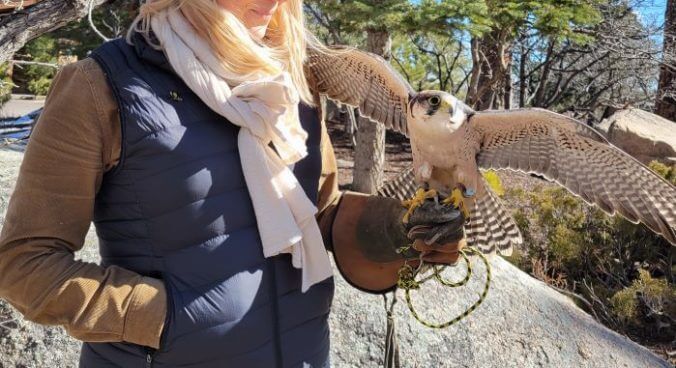The (Exhilarating) Falconry Program at The Broadmoor in Colorado
Photos courtesy of Melanie Carden
I could practically hear Sir David Attenborough’s voice as Earl, a peregrine falcon, sat casually on my hand while devouring a mouse—whole. It was as if I were immersed in Attenborough’s latest documentary, and he was reminding me of the circle of life.
Earl, on the other hand, just kept shifting and gyrating his neck to shimmy the mouse down the chute, so to speak. And this raw, exquisite display of the natural order of the animal kingdom played out just inches from my face.
Welcome to the incredible, fascinating hobby of falconry.
What The Heck Is Falconry All About, Anyhoo?
Before my getaway at The Broadmoor in Colorado Springs, Colo., I knew nothing of falconry. Why would I, really? Considering that the sport of falconry got its start within the elite circles of nobles from Medieval Europe, the Middle East, and the Mongolian Empire, it comes as no surprise that I was a noob of the highest ranking.
I’m far from the nobility and the earls—my falcon friend’s namesake—who once dominated the sport. Noob or not, I’m wholly fascinated with the inner workings of nature, and learning about the hunting proficiency of birds of prey, and how people have collaborated with them over time, was a unique opportunity. So, there I was, watching Earl choke down his high-value reward for a job well done.
Raptors Are Not Retrievers
The foundations of falconry remain essentially unchanged. Training birds of prey to assist in the hunt for food has been around for about 4,000 years. Unlike, for example, a hunting dog trained to retrieve, raptors generally won’t bring the catch—like a pheasant—back to you. They’re trained to catch it as you flush it out of its hiding spot. From there, you do the retrieving and reward the bird. This is pretty close to what I experienced at The Broadmoor. The one difference was it wasn’t a legitimate hunt but more of a practice.
The Falconry Program at The Broadmoor
During a beginner lesson, The Broadmoor’s master falconer, Deanna Curtis, introduces students to various captive-bred, trained birds, including owls, falcons, and hawks. The class includes an initial flying demonstration and the highly anticipated moment of awe—when each student can hold a trained hawk on their (gloved) fist. In my newly swayed opinion, however, plan your stay to allow time to also take the intermediate lesson; this is where the real magic happens.

-

-

-

-

-

-

-

-

-

-

-

-

-

-

-

-

-

-

-

-

-

-

-

-

-

-

-

-

-

-

-

-

-

-

-

-

-

-

-

-








































